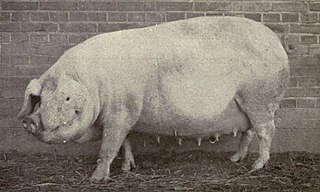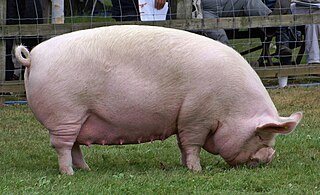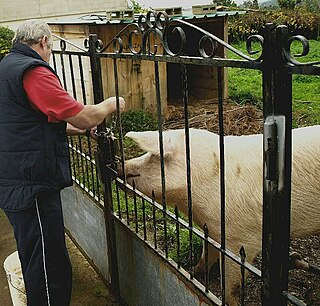
A landrace is a domesticated, locally adapted, often traditional variety of a species of animal or plant that has developed over time, through adaptation to its natural and cultural environment of agriculture and pastoralism, and due to isolation from other populations of the species. Landraces are distinct from cultivars and from standard breeds.

The Danish Landrace, Danish: Hvid Dansk Landrace, is a Danish breed of pig. It is of medium to large size, white in colour with a long body, fine hair, a long snout, and heavy drooping ears. There are two distinct varieties, the white and the piebald.

The American Landrace is an American breed of domestic pig. It is white in color, with a long body, fine hair, a long snout and heavy, drooping ears. Like all landrace pigs, it derives from the Danish Landrace.

The Essex is a breed of domestic pig originating in the United Kingdom.

The Lithuanian White is a Lithuanian breed of general-purpose pig. It was developed in the twentieth century in the Lithuanian Soviet Socialist Republic under the Lithuanian Animal Husbandry Research Institute of Baisogala, and was officially recognised in 1967. It derives from cross-breeding of local pigs with imported breeds including the Large White, the Deutsches Edelschwein and the German Landrace. It was bred for suitability to conditions in Lithuania, but spread to other parts of the Soviet Union including those that are now Belarus, Georgia, Kazakhstan, Turkmenistan and Moldova, and was also reared in parts of the Russian Republic.
The Aksai Black Pied is a distinctively black and white spotted pig breed from Kazakhstan.

The Wessex Saddleback or Wessex Pig is a breed of domestic pig originating in the West Country of England, (Wessex), especially in Wiltshire and the New Forest area of Hampshire. It is black, with white forequarters. In Britain it was amalgamated with the Essex pig to form the British Saddleback, and it is extinct as a separate breed in Britain. However, the Wessex Saddleback survives in Australia and New Zealand.

The British Saddleback is a modern British breed of domestic pig. It was created in 1967 by merging the surviving populations of two traditional saddleback breeds, the Essex and Wessex Saddleback. It is an endangered breed, listed on the watchlist of the Rare Breeds Survival Trust as at risk, the second-highest level of concern.

The Danish Landrace is a Danish breed of dairy goat.
A landrace is a type of domestic animal or plant adapted to the natural and cultural environment in which it originated, with minimal selective breeding. Some have "landrace" in the names:

The Middle White is a British breed of domestic pig. It originated in Yorkshire, and derived from the Large White and the now-extinct Small White. It was recognised in 1852, and the first herd-book was published in 1884. It is a porker, reared for fresh pork, and is characterised by a short and sharply-upturned snout. After the Second World War it came close to extinction; although numbers have recovered somewhat, it is listed by the Rare Breeds Survival Trust as "priority" – the highest level of risk.

The Welsh is a breed of domestic pig native to Wales. It is a large white breed known for its hardiness in outdoor (extensive) farming, its long, pear-shaped body and its lop-ears. The breed was first mentioned in the 1870s, and after the Howitt committee report in 1955, became the third most common sire in the United Kingdom after the Large White pig and British Landrace pig. The Welsh pig experienced a decline in numbers in the late twentieth century because consumer demands had changed and the carcase was considered too fatty. In 2005 the breed was considered endangered and later came under the auspices of the Rare Breeds Survival Trust. Since then numbers have expanded somewhat, and by 2012, the registered breeding herd had increased to over 1000 animals.

The Italian Landrace is an Italian breed of domestic pig. It derives from the Danish Landrace breed developed in Denmark at the end of the nineteenth century. Stock was imported into Italy after the Second World War. The breed has been selected principally for suitability for the production of prosciutto crudo. It is, after the Large White Italiana, the second-most numerous pig breed in Italy. The breed standard is issued by the Ministero delle Politiche Agricole Alimentari e Forestali, the Italian ministry of agriculture and forestry; the herdbook is kept by the Associazione Nazionale Allevatori Suini, the national pig-breeders' association.

The Swedish Landrace is the leading breed of pig in Sweden. They have heavy drooping ears and a white coat. The Swedish strain of the Landrace pig originated from importations from neighboring countries, particularly Denmark. The Swedish Landrace have attracted attention in the United States and other nations in recent years.

The British Landrace is a British domestic breed of pig and one of the most popular in the United Kingdom. It is pink with heavy drooping ears that cover most of the face and is bred for pork and bacon. The breed originated in the 1949 importation of 12 landrace pigs from Scandinavia — four boars and eight gilts. In 1950, the British Landrace Pig Society was formed and it opened a herd book for the first offspring born from the imported 12. They created the first pig testing scheme with a testing station at the village of Stockton-on-the-Forest in North Yorkshire.
The Lacombe is a breed of domestic pig native to Canada. Named for the Lacombe Research and Development Centre in Lacombe, Alberta, the breed was the first strain of livestock developed in the country.

The Göttingen minipig is a breed of miniature pig. The Göttingen minipig is the smallest domestic pig breed known in the world; as an adult, they weigh around 35 kg (77 lb). Beside being known for their exceptionally small size, the Göttingen minipigs are known for their docile nature and very clean and well-characterized health status. Raising of this breed began in the late 1960s at the Institute of Animal Breeding and Genetics at the University of Göttingen, Germany, by crossbreeding the Minnesota mini-pig, the Vietnamese Pot-bellied pig, and the German Landrace pig. Göttingen minipigs are highly favored as pets, however, the breed was specifically developed for biomedical research. Today, they are extensively bred at four separate locations globally.
The term Landrace pig, or Landrace swine, refers to any of a group of standardized breeds of domestic pig, and in this context, the word "Landrace" is typically capitalized. The original breed by this name was the Danish Landrace pig, from which the others were derived through development and crossbreeding. The breed was so named because the foundation stock of the Danish Landrace were specimens from the local, free-breeding, non-pedigreed stock of swine, i.e., the regional landrace native to Denmark. The modern breeds are not themselves landraces, since they are formal breeds maintained through selective breeding rather than natural selection. The establishment and spread of the Danish breed gave the word "landrace" to the English language. Sources from the mid-20th century often mean the Danish Landrace swine in particular when referring to "Landrace" pigs, as most of the others had not been developed yet.

The Estonian Red is an Estonian breed of dairy cattle. It was developed in the second half of the nineteenth century from cross-breeding of local cattle with imported stock of the Angeln, Danish Red and North Slesvig Red breeds. The coat is red, but sometimes it varies from red-white to brown and rarely black.
The Large White Ulster, or Ulster White, was a breed of domestic pig. Primarily bred for bacon production, it was the favoured breed of farmers in the north of Ireland up until the mid 20th century.














